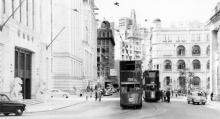Ashes Buoy [????-????]
Primary tabs
Position of marker is a guess. The buoy is mentioned in Gazette entry No. 336 for 21st October 1910:
Harbour Master’s Department.
No. 336.—It is hereby notified that the depositing of refuse in the waters of the Colony is strictly prohibited except at the undermentioned places:—
1. West of the Ashes Buoy at Kau I Chau, West of Green Island;
* 2. To the South of Cape Collinson on the early ebb tide :—
(a.) When the weather conditions at Kau I Chau are not favourable, and
(b.) With special permission from the Harbour Master.
Basil Taylor, Commander, R.N.,
Harbour Master, &c.
21st October, 1910.
* Note.—Special permission must be obtained from the Harbour Master to deposit refuse of any kind at any other place.
It's an early mention of Hong Kong's waste disposal, something I haven't seen discussed elsewhere. I wonder if the Ashes Buoy is related to Kennedy Town being known as "Lap Sap Waan", ie Rubbish Bay? The name could refer to the place where rubbish was loaded, or the place where any floating rubbish dropped at the Ashes Buoy would wash back ashore.


Comments
Re: Ashes Buoy
China Mail 11 March 1914 (Scroll to Page 7) Updated
Formerly the refuse of the city was dumped and burnt at what was now known as Kennedy Town and then taken over in junks to Gin Drinkers' Bay, where it was deposited at the high water mark and burnt. But it was found that in calm weather, when there was no wind many of the dust boats did not reach Gin Drinkers' Bay, but emptied themselves in some mysterious fashion enroute rather than go all the way to Gin Drinkers', and anything that could float would return and deposit itself on the foreshore of the harbour. In order to remedy this, a watch was set on the tides and the currents, and it was found that rubbish dumped at the "Ashes" near Cow-ee-Chow (sic) was not washed back to the harbour, and this point was later selected for refuse to be dumped. A steam laumch and steam barges were acquired to take refuse out to this spot and dumped into the sea regularly. But the nuisance was not abated, it was only pushed out of sight for the time.
Re: Ashes Buoy
Thanks Moddsey, I've wondered where Hong Kong's rubbish ended up, so this is an interesting read. Here's a link to that day's paper: https://mmis.hkpl.gov.hk/coverpage/-/coverpage/view?_coverpage_WAR_mmisp...